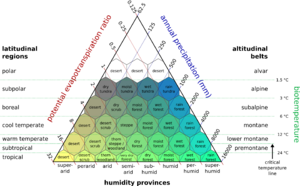World generation
The world is generated through a variety of different features procedurally generating to organically form different environments. Rather than discrete biomes, regions are formed through mechanics such as temperature, rocks, tree density, and water density.
Rock Layer Generation
Rock layers come in three general categories: igneous, metamorphic, and sedimentary. Each category of rocks has several specifc types of rocks in it, and when generating in the world, There can be multiple layers of each type (or none). The type of rocks has no effect on any flora or fauna generation. However it has a huge effect on what ores you may find in the area.
Tree Generation
Trees generate with different densities across the landscape, with some tree shapes only available through world generation that cannot be regrown.
Natural Resources
When exploring, there are different natural resources that the average explorer may be interested in.
Clay
Clay forms on the surface of the world, appearing in the form of either blue clay or fire clay. Clay does not generate in extreme hot or extreme cold climates.
Ores
Ore Deposits generate all over the underground in Vintage Story. It is very important to pay attention to the type of rocks that is nearby, as ores will only form in specific rocks types.
Rocks
Underneath the surface lies a large variety of different type of rocks. There are 22 different types of rocks, and each rock hosts a different selection of ores.
Soil
Different types of soil form over the landscape to form the surface. Some are more rare than others, with low fertility soil being the most common. The varying soil types have different levels of fertility, you may have to keep this in mind when choosing a location.
The rainfall amount seems to be directly tied to the average soil fertility, as 'very rare rainfall' correlates with almost only low fertility (or non at all) soil, whilst 'rain almost all the time' translates into almost only medium fertility soil. Terra Preta however seems to not be influenced by rainfall.
Crops
Crops or Wild Foods spawn once on world generation and very slowly grow when the chunk is loaded. A mature crop resets back to stage 1 eventually. They however do not multiply.
Temperature
The temperature is a vital part of deciding what wild foods can generate, whether or not clay can form, and even the weather.
Weather
The weather depends on the climate around it. As a guide, areas that are more green indicate a larger amount of rainfall.
Water
Environments are formed with varying levels of water density, this means that oceans, for example, are not force as a 'biome' but instead form organically.
Structures
Structures form over the world's surface and underground in the form of ruins. These structures often contain loot that can benefit survival in various ways. Some blocks, such as aged wooden planks, can only be found in these ruins.
History
Notes
Gallery
See also
References
| Wiki Navigation | |
|---|---|
| Vintage Story | Guides • Frequently Asked Questions • Soundtrack • Versions • Controls |
| Game systems | Crafting • Knapping • Clay forming • Smithing • Cooking • Temperature • Hunger • Mining • Temporal stability • Mechanical power • Trading • Farming • Animal husbandry |
| World | World generation • Biomes • Weather • Temporal storms |
| Items | Tools • Weapons • Armor • Clothing • Bags • Materials • Food |
| Blocks | Terrain • Plants • Decorative • Lighting • Functional • Ore |
| Entities | Hostile entities • Animals • NPCs • Players |
| Miscellaneous | List of client commands • List of server commands • Creative Starter Guide • Bot System • WorldEdit • Cinematic Camera • Adjustable FPS Video Recording • ServerBlockTicking |
